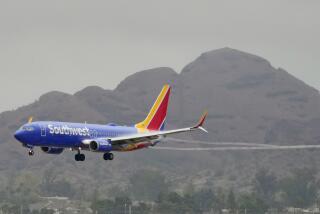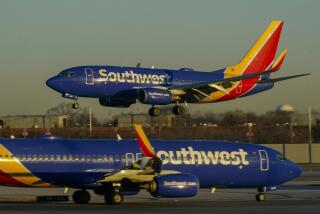Southwest Still Soaring as Other Airlines Stall
- Share via
DALLAS — Since last year’s Sept. 11 terrorist attacks, the nation’s airlines have had to deal with jittery passengers, increased security and mounting losses in the wake of a steep downturn in travel.
And then there’s the carriers’ ever-present domestic concern: the fun-loving, irreverent and always-profitable Southwest Airlines.
While other airlines are bleeding billions of dollars and shrinking fast, Dallas-based Southwest--the nation’s sixth-largest carrier and the biggest in the California market--is poised to eat their lunch by taking more of their passengers and market share.
Donald Carty, chairman of American Airlines and its parent AMR Corp., said as much when he recently noted that American must adapt to “an environment where ... lower-cost competition represents a much bigger slice of the marketplace.”
Moreover, if the competition thought that legendary Southwest co-founder Herb Kelleher would disappear after he retired as chief executive in mid-2001, they were wrong. Despite keeping a very low public profile, Kelleher, who remains chairman, is calling many of the shots at Southwest along with his successor, Chief Executive Jim Parker, and Southwest President Colleen Barrett.
One of those shots is where Southwest will expand next, or whether it will create more longer nonstop flights to supplement its core short-haul service. Industry experts foresee an expansion of service into the Chicago and Florida markets. “It’s not a decision either one of us [Parker or Barrett] is going to make, because it’s one of the things that Herb kept,” Barrett said of Kelleher, who declined to be interviewed. “He kept strategic planning, he kept fleet planning.
“I’m sure he will discuss things with us,” she said with her tongue partly in her cheek, “but they’ve always been his call in the end.”
Kelleher, 71, is the charismatic, zany force who created the culture, the business model and the financial discipline that has set Southwest apart during its 31-year history. And he’s the one who taught Southwest to take unrelenting aim at other airlines during their times of woe to garner more business for the carrier.
Southwest relishes moving into a city or route that’s underused or has been abandoned, launching flights with its cheap ticket prices and then turning a profit thanks to its remarkably low operating costs. That, too, is one of its trademarks. It’s the reason Southwest has not only doubled in size since 1995, but also has doubled its share of total U.S. passenger traffic to 8% from 4% in that period.
In 1991, for instance, US Airways pulled out of several California cities. “We said, ‘We’d love to be in Sacramento,’ ” recalled Gary Kelly, Southwest’s chief financial officer. “So boom, we went in.” That helped launch Southwest’s dominance of the intra-California market.
In the last year, the airline grabbed even more passengers in the West, after UAL Corp.’s United Airlines abandoned its West Coast shuttle program, and in Baltimore and other Eastern cities after US Airways grounded its Metrojet division.
Southwest’s low fares have never been more popular than during the current travel slump and are another significant reason the bigger carriers--with their higher costs and typically higher fares--are on the ropes. With the growing help of the Internet, both business and leisure travelers increasingly are searching for the cheapest fares, playing right into Southwest’s hands.
“They are sitting on a kind of treasure trove,” said Ron Kuhlmann, vice president of aviation consulting firm Unisys R2A in Hayward, Calif.
Southwest’s senior managers avoid talking publicly about exploiting their competitors’ troubles, in good part because Southwest--with 2,800 daily flights to 58 cities--has its share of problems. Its passenger revenue is down 9% for the first half of the year, and its profit is less than half what it was a year ago. Southwest’s famous on-time performance has slipped noticeably in recent months, which the carrier blames mostly on increased security measures and bad weather.
The company’s stock also has plummeted 43% since it peaked at $22 a share in late February--it closed Friday at $12.48 a share--as investors fret that the factors whipping the big carriers will impede Southwest’s growth. Even so, Southwest’s total stock market value of $9.7 billion remains twice that of all other major airlines combined.
Southwest’s executives acknowledge that the industry shakeout gives their airline another opportunity to build up while the others are tearing down. Southwest still has the money, the planes, the people and--most of all--the will to swoop in wherever other carriers pull out.
“Adding new cities is something we have historically done, and we will do it in the future,” Parker said. “But we’ve never taken on more than we could sustain.”
A Variety of Problems
Airlines with the biggest troubles include US Airways, which is in bankruptcy proceedings and plans to slash hundreds of flights as it overhauls its system. United is teetering toward Chapter 11 and probably will retrench regardless of whether it stays out of Bankruptcy Court. Industry leader American also has announced plans to trim its flight schedule, ground jetliners and eliminate 7,000 jobs.
Their outlooks seem to grow dimmer by the day. The prospect of a war against Iraq, with its attendant surge in jet-fuel prices and a further drop in travel by skittish passengers, has pummeled airline stocks to levels not seen in two decades. Airline executives, meanwhile, recently went to Capitol Hill seeking more federal aid in the form of relief from soaring insurance and security costs.
As the other large carriers shrink, Southwest wants to keep growing, though Parker and other executives are careful not to suggest where the airline will expand next. That could well depend on where those other airlines pull back. “If one of our competitors reduces service in a market, it [that city] may very well rise to the top of the list,” Kelly said.
“More nonstops is another way we can grow,” Parker said, referring to Southwest’s bold strategy of expanding beyond its basic short-run flights with routes that span the continent--a direct volley at larger network airlines such as American and United. Last month Southwest launched its first nonstop transcontinental service, from Los Angeles to Baltimore.
“Southwest is replacing traditional network carriers,” analyst Ray Neidl of Blaylock & Partners said in a recent report.
But Southwest won’t just jump into any new airport or route, cautioned Kuhlmann of Unisys R2A. Southwest always has avoided, where possible, congested airports because they impede its efficiency, so “I don’t expect Southwest will go into Boston or San Francisco,” he said. (It flies to Providence, R.I., and Oakland instead.) Likewise, “in a lot of their short-haul markets they’re pretty much maxed out” in terms of daily service, such as Southern California to the San Francisco Bay area, he added.
Instead, “I would expect Southwest is going to exploit further its Chicago Midway-West Coast” service, and it might add more routes to California and the West from its growing presence in Fort Lauderdale and Orlando in Florida, Kuhlmann said.
U.S. carriers lost more than $7 billion last year, slammed by the recession, a precipitous drop in business travel, the general travel downturn after the terrorist attacks, rising jet-fuel costs and by higher labor contracts that they approved. The figures would have been worse without a $15-billion federal bailout organized after Sept. 11 that included $5 billion of cash grants disbursed among the carriers.
The other airlines slashed their operations and laid off more than 80,000 workers to save cash. Southwest neither trimmed its system nor laid off employees--it has never had layoffs--and still finished 2001 with profit of $511 million (including one-time gains and charges) on revenue of $5.6 billion.
Many in the industry expected air travel to improve as this year progressed, but it hasn’t. Analysts predict that the industry, which also is grappling with increased security and insurance costs, could lose $7 billion this year.
Southwest earned $124 million in the first half of this year and is expected to turn a profit for all of 2002. Barrett said a profit provides value not just to stockholders but to Southwest’s 35,000 employees.
“A non-growing company is the quickest way to have morale go to pot,” she said.
Southwest’s big competitors have tweaked their operations before during financial slumps, but their condition is so grave this time that they’re talking about a radical overhaul of the way they do business. Airlines such as American and United spend 10.5 cents to 11.5 cents to fly one passenger one mile. Southwest’s cost: 7.4 cents.
That’s why Southwest can price its seats so low and still make money. There are other reasons. Southwest flies only one type of plane, the Boeing 737, which saves on maintenance and training costs. Those planes are used more productively--Southwest quickly turns them around at airports so the jets spend more time in the air--with paying passengers--than on the ground.
Experienced Executives
For Parker and Barrett, learning their new jobs has been a baptism by fire. They had succeeded Kelleher as CEO and president, respectively, only three months before the terrorists struck New York and the Pentagon and U.S. air travel was briefly grounded for the first time.
But they had the advantage of being longtime Southwest executives who had worked closely with Kelleher and each other.
They toil in windowless offices, just as Kelleher did--he once said the sure sign of a bureaucrat is someone preoccupied with the window space they have--at Southwest’s headquarters at Dallas’ Love Field. Every few minutes, a Southwest jet touches down in front of the building’s main entrance.
Parker is an engaging and easy-going 55-year-old who had been Southwest’s general counsel. He spends much of his time focused on labor and financial matters and politely answering the recurring questions about how he compares with the heralded, fun-loving Kelleher.
“Nobody can be another Herb Kelleher, and I haven’t even tried,” he said.
Kelleher, for his part, has refused most interview requests since passing the baton, to keep the focus on Parker instead of him. “Herb has made it easier by not having a high profile during this period, and that was very thoughtful,” Parker said.
Barrett, the highest-ranking woman in the airline industry, began as Kelleher’s legal secretary in the 1960s and has been with him since. She often is described as the alter ego of “Herbie,” as she calls him, but Barrett also has worked with Parker for years, so “there has been no change for me” since Parker became CEO, she said.
A self-described “communication freak” who nonetheless chooses her words carefully during interviews, Barrett, 58, doesn’t dispute suggestions that she oversees Southwest’s famed culture and customer service, among other things. So Sept. 11 presented her with an enormous test, because she believed she had to tell her upbeat employees to cool it.
“For the first time ever since our inception, I believe, I actually put out a request ... that we needed to basically squash our humor” for a while, Barrett recalled in her modest office, which is chock-full of arts, crafts and memorabilia.
“My feeling was that emotions were very raw” and not receptive to Southwest’s style, Barrett said.
But Southwest was the first airline to resume advertising after the attacks, and it wasn’t long before it returned to its fun-loving ways.
But there’s been nothing funny about the depressed level of ticket revenue at Southwest and throughout the airline industry.
“Times are really, really scary,” Barrett said. “People aren’t willing to pay a whole lot more to travel.” Yes, Southwest specializes in selling low fares, but even Southwest needs to nudge prices higher and get more people on its 737s to generate its profit of old.
“The challenge,” Parker said, “will be to get them back in the habit of paying us enough where we can make a reasonable profit,” which is likely to make Southwest’s rivals anything but upbeat.
More to Read
Inside the business of entertainment
The Wide Shot brings you news, analysis and insights on everything from streaming wars to production — and what it all means for the future.
You may occasionally receive promotional content from the Los Angeles Times.











